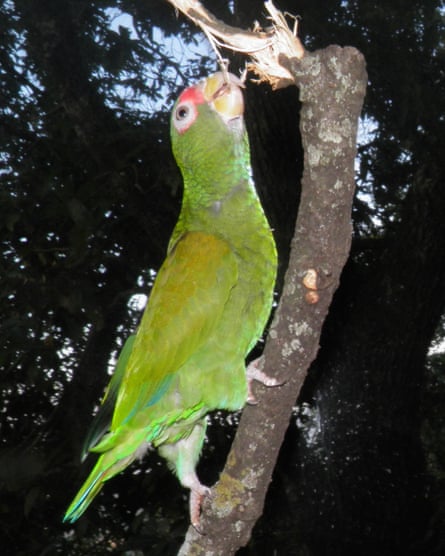Miguel Gómez Garza was on his final expedition to the Yucatán Peninsula to gather information for his book Parrots of Mexico when it happened. He heard a group of parrots in the distance, but their call was like none on record. So he loitered by a tree full of pods that parrots like for lunch, hoping they would come and feed.
The wait was worth it. When half a dozen parrots flew over to the tree, Gómez Garza noticed their intense red fronts and the beautiful blue tips on their wing feathers. The plumage set them apart from the two species known to live in the area, which both have distinctive white fronts.

“I could not believe it. The different noise belonged to a different parrot,” said Gómez Garza, a vet and ornithologist at the Autonomous University of Nuevo León in Monterrey, Mexico.
In research published on Tuesday, an international team of scientists describe the new parrot for the first time. Named the blue-winged Amazon parrot, or Amazona gomezgarzai in honour of its discoverer, the bird stands 25cm or so tall and has a loud, short and repetitive call that would not sound out of place on the soundtrack to Alfred Hitchcock’s Psycho.
One of the calls the bird makes imitates that of the hawk, a natural enemy of parrots. While scientists are not sure why the parrot mimics the predator, they speculate that it scares other birds from the surrounding trees, leaving more seeds, fruit and flowers for the parrots to eat.
Having spotted the birds in their habitat, Gómez Garza got permission from the Mexican authorities to capture a male and a female for further study. With help from Tony Silva at the University of Florida and Pawel Mackiewicz at the University of Wroclaw, he measured the animals and collected feather and blood samples.
Tests on the parrot DNA described in the journal PeerJ show that the new species evolved from the white-fronted parrots (Amazona albifrons) that were native to the region about 120,000 years ago. Given their rarity, the tests were performed without harming the parrots. “I believe this is the first time in recent history that a scientific description has been done without having to terminate its life,” Gómez Garza said. He added that plans are already being drawn up to protect the species.
Mackiewicz said that there were probably no more than 100 blue-winged Amazon parrots in existence, making their conservation a priority.
“Globally, parrots face habitat destruction,” said Gómez Garza. “The international illegal trade is not as alarming as it was a few years ago, but continues locally with some species. Awareness will be the turning point in saving wild parrots around the world.”

Comments (…)
Sign in or create your Guardian account to join the discussion